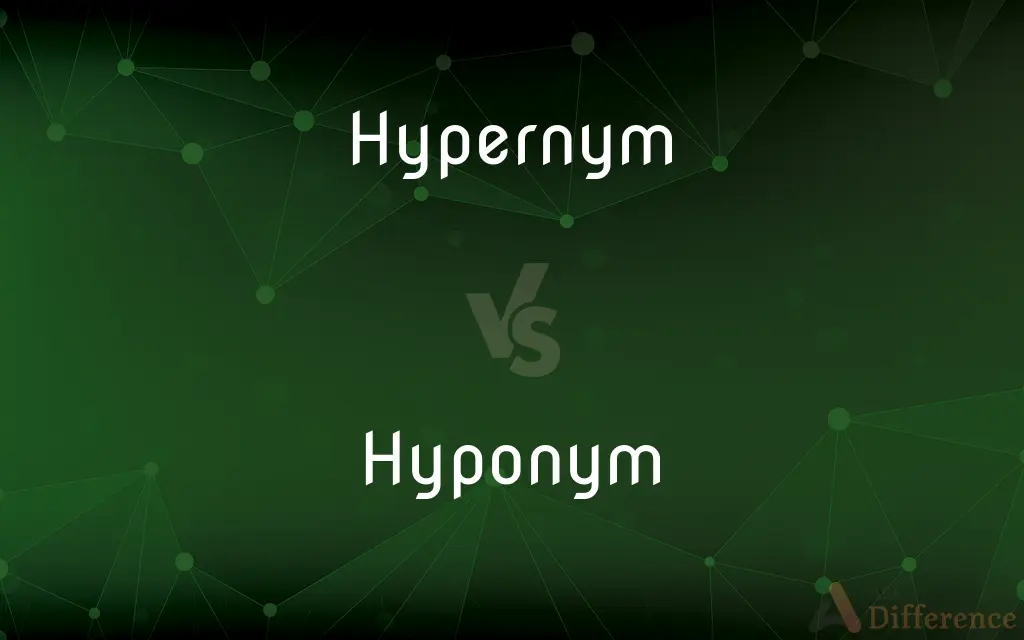Hypernym vs. Hyponym — What's the Difference?
By Tayyaba Rehman & Maham Liaqat — Updated on March 27, 2024
A hypernym is a word with a broad meaning that encompasses various subcategories, while a hyponym is a more specific term within those categories.

Difference Between Hypernym and Hyponym
Table of Contents
ADVERTISEMENT
Key Differences
A hypernym functions as a broad category under which more specific terms, or hyponyms, fall. For example, "flower" is a hypernym that includes roses, daisies, and tulips as its hyponyms. On the other hand, a hyponym provides a detailed and specific representation within a broader category. Roses, daisies, and tulips, as hyponyms, specify types of flowers.
Hypernyms are used in language to refer to general categories or groups without specifying details. This makes them useful in conversations where the specific type or kind is either unknown or irrelevant. Whereas hyponyms, by their nature, convey more specific information, often used when details about the subtype of a category are important or when specificity is needed to clarify or add detail to a conversation.
In hierarchical structures of knowledge or language, hypernyms sit at a higher level than hyponyms. They are like umbrella terms under which the narrower and more specific hyponyms are grouped. Whereas hyponyms represent the diversity and specificity within the broad categories established by hypernyms, showcasing the depth and variety within a category.
The relationship between a hypernym and its hyponyms is fundamental to organizing knowledge in fields such as linguistics, biology, and information science. Hypernyms provide a way to categorize and structure information, while hyponyms fill out the details within these categories. On the other hand, the specific nature of hyponyms helps in detailed classification and understanding of the nuances within a broader category.
Understanding the distinction between hypernyms and hyponyms is crucial in language processing and semantic analysis, where it aids in accurately interpreting the meaning of texts and in tasks such as automatic classification and information retrieval. Whereas the precise use of hyponyms can enhance the specificity and clarity of communication, making it easier to convey detailed or specialized information.
ADVERTISEMENT
Comparison Chart
Definition
A word with a broad meaning encompassing a group of more specific words.
A specific word within a broader category represented by a hypernym.
Function in Language
Refers to general categories or groups.
Specifies details within a broader category.
Hierarchy
Sits at a higher, more general level.
Falls under a hypernym, representing a more detailed level.
Usage in Communication
Used when specific details are unknown or irrelevant.
Used to convey specific information or detail.
Role in Knowledge Organization
Categorizes and structures broad areas of knowledge.
Adds specificity and detail within these broad categories.
Compare with Definitions
Hypernym
A word that encompasses a broad category of more specific terms.
Vehicle is a hypernym of car.
Hyponym
A more specific term within a broader category defined by a hypernym.
Sparrow is a hyponym of bird.
Hypernym
Used to refer to groups or classes in a general sense.
Animal is a hypernym for species like dogs and cats.
Hyponym
Provides detailed specification within a category.
Tulip is a hyponym of flower.
Hypernym
Represents higher-level concepts or categories.
Furniture is a hypernym for chairs and tables.
Hyponym
Adds specificity and clarity by detailing subcategories.
Sedan is a hyponym of car.
Hypernym
Broadens the scope of conversation by using general terms.
Drink is a hypernym for coffee and tea.
Hyponym
Represents the diversity within broader categories.
Maple is a hyponym of tree.
Hypernym
Categorizes specific instances under a general term.
Fruit is a hypernym for apples and oranges.
Hyponym
Used to convey specific details in communication.
Bulldog is a hyponym of dog.
Hypernym
A word whose meaning includes the meaning of a more specific word; for example, animal is a hypernym of elephant.
Hyponym
A word whose meaning is included in the meaning of another more general word; for example, bus is a hyponym of vehicle.
Hypernym
(semantics) A superordinate word or phrase; a term whose referents form a set which includes as a subset the referents of a subordinate term—as, for example, insect being (a hypernym) for ant.
“Musical instrument” is a hypernym of “guitar” because a guitar is a musical instrument.
Hypernyms of “dog” and “cat” include “mammal”, “pet”, “carnivore”, and “quadruped”.
Hyponym
(semantics) A more specific term; a subordinate grouping word or phrase; a term designating a subclass of another more general class described by the given word.
The words “dog”, “cat”, and “human” are hyponyms of “animal” because dogs, cats, and humans are types of animal.
Hypernym
A word that is more generic or more abstract than a given word; a word designating a class of which the given word is a member. Inverse of subtype and hyponym.
Hyponym
A word that is more specific (less abstract) than a given word; a term designating a class which is a subtype of the given word; a subcategory; a subtype. Inverse of hypernym; as, "dog" is a hyponym of "mammal", and "mammal" is a hyponym of "vertebrate".
Hypernym
A word that is more generic than a given word
Hyponym
A word that is more specific than a given word
Common Curiosities
What is a hypernym?
A hypernym is a word with a broad meaning that includes various specific subcategories.
What role do hypernyms play in knowledge organization?
Hypernyms categorize and structure broad areas of knowledge, serving as umbrella terms.
How do hypernyms function in language?
Hypernyms function as general terms referring to categories or groups, useful for broad references.
What makes hyponyms crucial for detailed communication?
Their specificity enhances clarity and precision in conveying detailed or specialized information.
What is a hyponym?
A hyponym is a specific term within a broader category represented by a hypernym.
Why are hypernyms important in language processing?
They aid in semantic analysis, interpretation, and automatic classification by providing general category references.
What impact do hypernyms have on hierarchical knowledge structures?
They establish foundational categories that structure the hierarchy, making information easier to navigate.
How are hyponyms used in communication?
Hyponyms are used to convey specific information or details within a broader category.
How do hypernyms and hyponyms relate to each other?
Hyponyms are specific instances that fall under the broader category defined by a hypernym.
How do hypernyms help in organizing information?
They provide a framework for grouping related specific terms, facilitating understanding and retrieval of information.
Can a word be both a hypernym and a hyponym?
Yes, depending on context, a word can serve as a hypernym for some terms and a hyponym for others.
How does the use of hyponyms affect text analysis?
The specificity of hyponyms enhances text analysis by providing detailed insights and improving information retrieval.
What is an example of a hypernym and its hyponyms?
"Bird" is a hypernym for "sparrow," "eagle," and "penguin," which are hyponyms.
How can understanding hypernyms and hyponyms benefit learners of English?
It helps in expanding vocabulary, understanding context, and improving the precision of language use.
Can hyponyms help in specific fields of study?
Yes, in fields like biology or linguistics, hyponyms add depth to the classification and study of subjects.
Share Your Discovery

Previous Comparison
House vs. Residence
Next Comparison
Court vs. GroundAuthor Spotlight
Written by
Tayyaba RehmanTayyaba Rehman is a distinguished writer, currently serving as a primary contributor to askdifference.com. As a researcher in semantics and etymology, Tayyaba's passion for the complexity of languages and their distinctions has found a perfect home on the platform. Tayyaba delves into the intricacies of language, distinguishing between commonly confused words and phrases, thereby providing clarity for readers worldwide.
Co-written by
Maham Liaqat













































